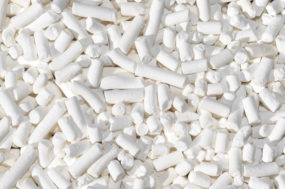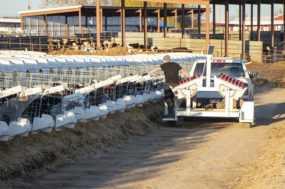When I met with Ted Carpenter and Paul Kelly more than 18 months ago, they had an idea that seemed almost too good to be true. I remember leaving the conversation thinking: “If they can prove what they are saying, then what they have to say would really be worth saying!” I am here to make good on my thoughts, because Bio-Environmental Solutions for Today (BEST) has lived up to its end of the conversation.
In the past, Ag Nutrient Management has addressed the idea of composting animal carcasses as a viable way to deal with the unpleasant, yet important, work of large-animal disposal when untimely death occurs. In speaking with producers who use this method of carcass management, the biggest issue tends to be the length of time required to go from the beginning to the end of the process. Inclement weather and lack of space also tend to put a damper on using this type of carcass management as a good option for many producers. It is a good idea and does work, but Mother Nature tends to take her time and be a bit finicky.
During June of 2007, Bingham County, Idaho became the site of a unique test to determine if there was a better way to deal with the discarded byproducts of not only animal production, but of construction, demolition, and every-day living. Under the direction of protocols set up by the State of Idaho Veterinarian, the Idaho Department of Environmental Quality, and the Idaho Department of Health, BEST was given the opportunity to demonstrate its newly developed process – Microbially Accelerated Regeneration Science (MARS™).
Backtrack a couple of years to when Ted Carpenter, Ph.D. came to know Mark Christensen and Paul Kelly. For years, Ted had been involved with the EPA, USDA, and international environmental agencies looking into various ways to deal with environmental problems while finding more sustainable practices for agriculture and industry. The three men combined their talents with the idea that Mother Nature had the ability to deal with many problems; she simply needed the right boost to make her process work more rapidly.
With thousands of hours of practical work and this idea bringing them together, Mark and Paul helped Dr. Carpenter to develop MARS™. What sounds like the next great rock band or child’s play toy actually is taking what happens naturally and increasing its speed.
BEST summarized the process with this statement:
“This process uses a consortium of bacterial and fungal organisms capable of producing hundreds of exodigestive enzymes which disassemble non-viable organic matter. It turns manure, sewage sludge, construction or disaster debris, animal carcasses, food production residues, yard trimmings, weeds, agriculture field debris, organic landfill materials, and other garbage into valuable compost within 60 days. It eliminates objectionable odors within hours. It also destroys carcinogenic hydrocarbons, human and animal pathogens, parasitic worms, insect pests, and weed seed.”
“Composting with our proprietary microbial culture is more efficient and recovers more nitrogen faster than any current means used. Because the thermophilic composting process produces temperatures between 130º and 160ºF for more than 30 days, it kills weed seed, insects, pathogens, and other pests. There is no release of methane. This composting process enables the retention of more nutrients than conventional methods with their losses of nitrogen, phosphorus, potassium, sulfur, calcium, magnesium, and other micronutrients into the atmosphere during each of many windrow turnings. Despite the considerable advantage in applying compost to the soil, many farmers will not do it because of weed seed and pathogens in the compost.”
The test in June combined municipal landfill materials with three hundred animal carcasses placed in four windrows by assembling a new segment daily during four weeks. Of these carcasses, more than 100 weighed 500 pounds or more. BEST’s demonstration included dairy cows, horses, hogs, sheep, goats, and beef cattle along with smaller animals. These were placed on a bed of old hay, old straw, dry grass clippings, or wood shavings; and all animals were treated with the proprietary microorganisms. Then Mother Nature (or Micro Nature!) was allowed to “do her thing.”
The Results
All windrow temperatures were monitored daily. Less than 24 hours after a windrow segment was assembled, temperatures rose to the thermophilic range and remained there until the piles were turned on July 11 (when the final segment had been composting for only 10 days!). What was even more noticeable was that all of the animals had been completely digested in a period of less than 60 days with no leachate or rotting-carcass odor from the windrows. The process completely transformed the construction debris, municipal trash, and animal carcasses into a nutrient-rich blend that most composting processes require six or more months to achieve. In addition, all diseases and carry-over pests for which laboratory tests were requested were undetectable.
Now that the initial testing of the MARS™ process is complete, there is little doubt that there is something here that can help producers in the future. In going over the test results, several items stood out:
• All Staphylococcus aureus and Salmonella were destroyed.
• No Phytophora, Pythium, Fusarium, Rhizoctonia, or Verticillium were found. All of these are common diseases that routinely plague the farming industry.
• No fecal coliforms (including Escherichia coli / E.coli) were detected in the final compost.
• Tests were negative for the presence of antibiotic pharmaceuticals: Gentamicin, Neomycin, Oxytetracycline, Penicillin G, Sulfadimethoxine, and Sulfamethazine.
• Engineered wood (pressboard, chipboard, and waferboard) – abundant in the tested landfill materials – is made with formaldehyde-loaded adhesives. All traces of this neurotoxin were negative after the short composting process. (A full list of test results can be found at the BEST Internet site noted at the end of this article.)
Although the process of composting has been looked at in agriculture for centuries, never before has it taken place at such speed with these results. In looking at the opportunity to work with the agricultural community, Paul stated:
“Dairymen, by almost any standard, are doing a superb job of producing quality milk for Americans. Truly, this industry sets a standard for the world. Currently, the dairy industry faces a few challenges – some are brought on by urbanites moving to country estates. Despite the finest efforts of the dairy industry, the tangs of odors sometimes waft across property lines.”
“We believe that the results of BEST’s composting trial verify a valuable tool that dairymen and feedlot operators can use. The rapidity with which the MARS™ process eliminates manure, animal carcasses, and offensive odors is an important step forward. Although there is much research that we want to do regarding applications such as in-field nematode bio-control, it can be said that this process alleviates serious problems facing agriculture and society.”
When Mark was asked what one thing he hoped people would remember from this test, he answered:
“There are many alternatives out there for people to use when facing nutrient management issues. We hope to be able to work with farmers and farming communities to provide a unique and viable option in dealing with the problems that they face today. This process allows both farmers and farm-containing communities to create a sustainable, community-friendly product that benefits everyone.”
Although there are no easy answers when dealing with the byproducts of animal agriculture, what I have seen during the past few months (especially now that the test results are available) leads me to believe that the MARS™ process is something that should be considered. What Paul, Mark, and Ted have started is something from which we all may benefit in the future. ANM
—More information on the MARS™ test can be found via: www.bio-environmentalsolutions.com or at 208-522-4228.






